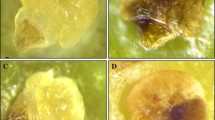Abstract
Two natural enemies of the mealybugRastrococcus invadens, the parasitoidGyranussoidea tebygi and the pathogenHirsutella cryptosclerotium were tested. Levels of parasitism by the parasitoid were reduced by the pathogen but overall mortality of the mealybug was greater both when agents were acting together.
Résumé
Deux ennemis naturels de la cochenilleRastrococcus invadens Williams ont été testés simultanément: le parasitoïdeGyranussoidea tebygi Noyes et le pathogèneHirsutella cryptosclerotium Fernandez-Garcia. Les niveaux de parasitisme de l'hyménoptère sont réduits en présence du pathogène, que celui-ci ait été appliqué avant ou après l'exposition des cochenilles au parasitoïde. Cependant, la mortalité globale des cochenilles est plus importante lorsque les agents agissent ensemble. Il est peu probable que le pathogène réduise de façon sensible le contrôle queG. tebygi exerce actuellement en Afrique de l'Ouest.
Similar content being viewed by others
References
Agounké, D., Agricola, U. &Bokonon-Ganta, H. A. — 1988.Rastrococcus invadens Williams [Hemiptera: Pseudococcidae], a serious exotic pest of fruit trees and other plants in West Africa. —Bull. Entomol. Res., 78, 695–702.
Agricola, U., Agounké, D., Fischer, H. U. &Moore, D. — 1989. The control ofRastrococcus invadens Williams [Hemiptera, Pseudococcidae] in Togo by the introduction ofGyranussoidea tebygi Noyes [Hymenoptera: Encyrtidae]. —Bull. Entomol. Res., 79, 671–678.
Fernandez-Garcia, E. &Moore, D. — 1988.Hirsutella sphaerospora as a potential biocontrol agent ofRastrococcus invadens Williams. —Brighton Crop Prot. Conf.-Pests & Diseases, 1988, 1125–1130.
Fernandez-Garcia, E., Evans, H. C. & Samson, R. A. — 1990.Hirsutella cryptosclerotium sp. nov. an entomopathogen of the mealybug pest,Rastrococcus invadens, in West Africa. —Mycol. Res., 95, 000-000.
Fransen, J. J. — 1987.Aschersonia aleyrodis as microbial agent of greenhouse whitefly. —PhD Thesis, University of Wageningen: The Netherlands.
Keller, S. — 1975. Histologische Untersuchungen an parasitierten,Entomophthora-infizierten Erbsenblattläusen,Acyrthosiphon pisum. —Mitt. Schweiz. Entomol. Ges., 48, 247–252.
Le Rü, B. &Iziquel, Y. — 1990. Nouvelles données sur le déroulement de la mycose àNeozygites fumosa sur la cochenille du maniocPhenacoccus manihoti. —Entomophaga 35, 173–183.
Moore, D. — 1988. Agents used for biological control of mealybugs [Pseudococcidae]. —Biocontrol News and Information, 9, 209–225.
Narasimham, A. U. &Chacko, M. J. — 1988.Rastrococcus spp. [Hemiptera: Pseudococcidae] and their natural enemies in India as potential biocontrol agents forR. invadens Williams. —Bull. Entomol. Res., 78, 703–708.
Nemeyye, P. S., Moore, D. &Prior, C. — 1990. Potential of the parasitoidHeterospilus prosopiodis [Hymenoptera: Braconidae] as a vector of plant-pathogenicColletotrichum spp. —Ann. Appl. Biol., 116, 11–19.
Willink, E. &Moore, D. — 1988. Aspects of the biology ofRastrococcus invadens Williams [Hemiptera: Pseudococcidae] a pest of fruit crops in West Africa, and one of its primary parasitoidsGyranussoidea tebygi [Hymenoptera: Encyrtidae]. —Bull. Entomol. Res., 78, 709–715.
Author information
Authors and Affiliations
Rights and permissions
About this article
Cite this article
Akalach, M., Fernandez-Garcia, E. & Moore, D. Interaction betweenRastrococcus invadens [Hom.: Pseudococcidae] and two natural enemies. Entomophaga 37, 99–106 (1992). https://doi.org/10.1007/BF02372978
Received:
Accepted:
Issue Date:
DOI: https://doi.org/10.1007/BF02372978
Key-Words
- Rastrococcus invadens
- Gyranussoidea tebygi
- Hirsutella cryptosclerotium
- parasitoid-pathogen interaction



